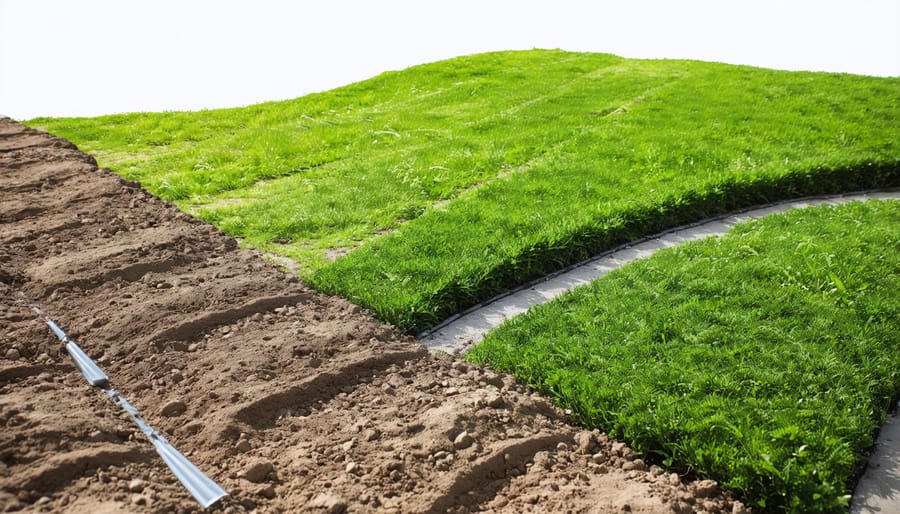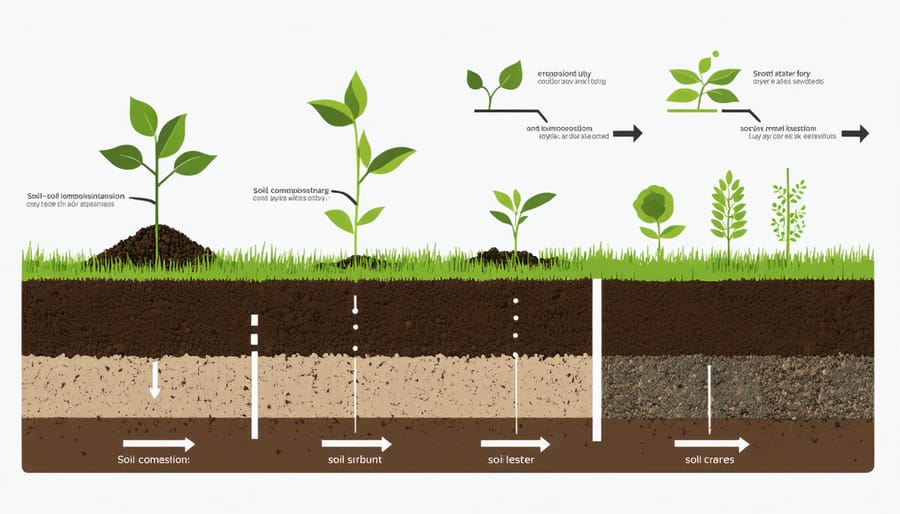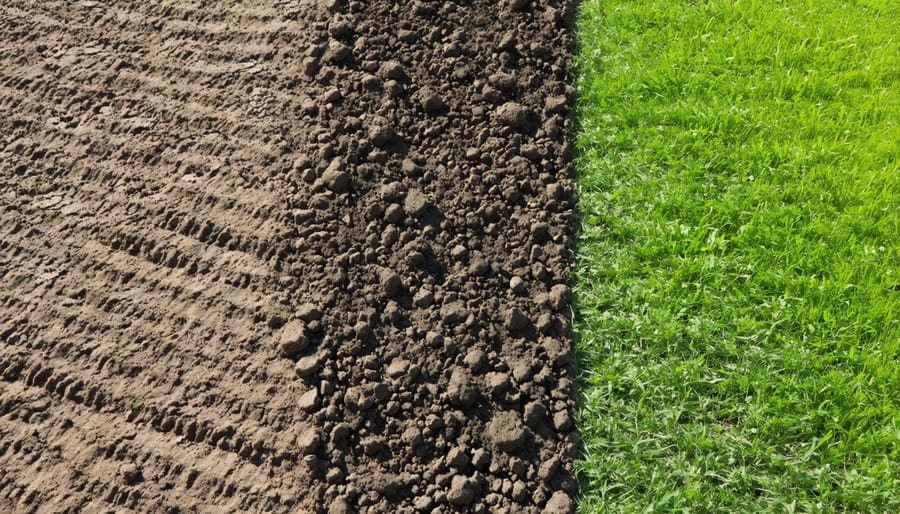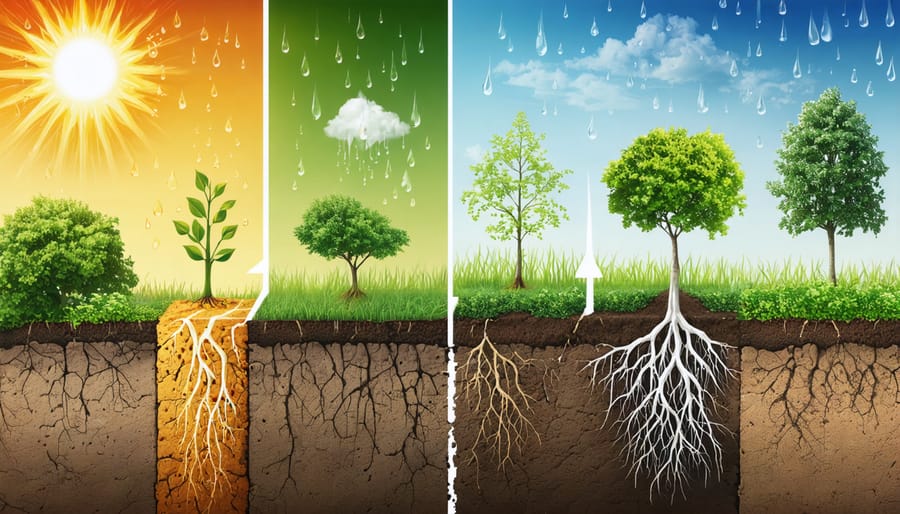The intricate dance between soil and environment shapes every successful garden’s story. Understanding your soil’s composition – from its mineral content to organic matter – opens the door to creating thriving, sustainable landscapes that work in harmony with your local climate. Whether you’re tending a sun-baked Mediterranean garden or nurturing plants in cool, temperate conditions, your soil’s physical properties directly influence water retention, nutrient availability, and root development.
Think of soil as your garden’s living foundation, constantly responding to temperature fluctuations, rainfall patterns, and seasonal changes. Clay particles cluster tightly in cold conditions, while sandy soils drain rapidly under intense sun. This dynamic relationship between climate and soil structure determines everything from microbial activity to plant health.
By mastering the connection between your physical environment and soil composition, you’ll unlock nature’s own solutions for common gardening challenges. Learn to read your soil’s signals, adapt your techniques to local conditions, and create resilient growing spaces that thrive year after year. The journey begins with understanding what lies beneath your feet – a complex world where geology meets biology, and where successful gardening starts long before the first seed is planted.
Understanding Your Garden’s Physical Environment
Sunlight and Shade Patterns
Sunlight and shade patterns play a crucial role in your soil’s health and behavior. When sunlight hits your garden, it doesn’t just feed your plants – it creates a complex relationship with soil moisture and temperature that can make or break your gardening success.
Areas that receive full sun tend to have warmer, drier soil, as direct sunlight increases evaporation rates. These sunny spots might need more frequent watering, especially during summer months. On the flip side, shaded areas retain moisture longer but may struggle with temperature regulation, often remaining cooler and taking longer to warm up in spring.
The daily dance of sun and shade also affects soil microorganisms. Sunny areas typically have more active biological processes, which can speed up organic matter decomposition. Shaded spots, while slower to warm up, often maintain more consistent moisture levels that some beneficial organisms prefer.
Understanding these patterns helps you make smarter gardening choices. For example, you might group plants with similar water needs based on your yard’s natural light exposure, or adjust your watering schedule according to different areas’ sun exposure.
Topography and Drainage
The way your land slopes and how water moves across it plays a crucial role in shaping your soil’s composition. Think of your garden as a mini watershed – when it rains, water naturally flows from higher to lower ground, carrying soil particles, nutrients, and organic matter along with it.
On steeper slopes, soil erosion can be a significant challenge. The rushing water can wash away valuable topsoil, leaving behind less fertile subsoil. This process not only affects the soil’s texture but also its nutrient content. In contrast, flat or gently sloping areas tend to retain more moisture and accumulate organic matter, creating richer soil conditions.
Low-lying areas often become natural collection points for water and sediments. While this can lead to nutrient-rich soil, it might also result in poor drainage and waterlogged conditions. The key is finding the right balance – you want enough slope for proper drainage but not so much that your soil washes away with every rainfall.
Understanding your property’s natural topography helps you make smart decisions about garden placement, erosion control, and drainage solutions. Working with, rather than against, your land’s natural features will lead to healthier soil and more successful growing conditions.

Local Climate Considerations
Your local climate plays a crucial role in shaping your soil’s characteristics and behavior throughout the year. Rainfall patterns, temperature fluctuations, and seasonal changes all influence soil moisture, nutrient availability, and microbial activity. Understanding these climate zone considerations helps you make informed decisions about soil management.
In areas with heavy rainfall, soils tend to be more acidic due to natural leaching of minerals, while arid regions often have alkaline soils with mineral buildup. Freeze-thaw cycles in colder climates can affect soil structure, creating natural tillage but potentially damaging root systems. Hot, dry conditions can lead to rapid moisture loss and soil crusting, making it crucial to implement proper mulching and irrigation strategies.
Remember that your local weather patterns should guide your soil amendment timing and choices, ensuring your garden thrives in harmony with nature’s rhythms.
Decoding Your Soil’s Composition

Soil Texture and Structure
Soil texture and structure are like the foundation of your garden’s success story. When you pick up a handful of soil, you’re actually holding a complex mixture of differently-sized particles: sand, silt, and clay. Sandy soil feels gritty between your fingers and drains quickly, while clay soil is smooth when dry and sticky when wet. Silt particles fall somewhere in between, feeling rather like flour when dry.
The ideal soil, often called loam, contains a balanced mix of all three particles. Think of it as nature’s perfect recipe: roughly 40% sand, 40% silt, and 20% clay. This combination creates soil that both retains moisture and allows excess water to drain away, while providing plenty of space for roots to grow and beneficial organisms to thrive.
Soil structure refers to how these particles clump together to form aggregates. Good soil structure resembles small crumbs or granules, similar to breadcrumbs. These formations create essential pore spaces that allow air, water, and roots to move freely through the soil. You can improve your soil’s structure by adding organic matter, such as compost or well-rotted manure, which acts like a natural glue holding these aggregates together.
A simple way to test your soil texture is the ribbon test: wet a handful of soil and try to form it into a ribbon between your thumb and forefinger. The longer the ribbon you can make, the more clay your soil contains.
Organic Matter Content
Organic matter is the lifeblood of healthy soil, playing a crucial role in creating the perfect environment for plants to thrive. Think of it as nature’s own slow-release fertilizer, continuously feeding your garden while improving soil structure and water retention.
When we talk about organic matter, we’re referring to decomposed plant and animal materials like fallen leaves, grass clippings, compost, and even beneficial earthworm castings. These materials work together to create a rich, dark soil that gardeners often describe as having a pleasant earthy smell – a true sign of soil health!
The benefits of organic matter are remarkable. It creates spaces between soil particles that allow roots to breathe and grow, while also holding onto water like a sponge. This means less frequent watering and stronger plant root systems. Organic matter also houses billions of beneficial microorganisms that break down nutrients into forms your plants can easily use.
For best results, aim to maintain organic matter levels between 3-5% in your garden soil. You can achieve this by regularly adding compost, using mulch, and incorporating cover crops into your garden plan. Even coffee grounds and vegetable scraps from your kitchen can contribute to building organic matter content over time.
Remember, building organic matter is a gradual process, but the rewards are worth the patience. Your plants will thank you with vigorous growth and abundant harvests!
Mineral Content and pH Levels
Understanding your soil’s mineral content and pH levels is like getting to know your garden’s personality – it tells you exactly what your plants need to thrive. Essential minerals like nitrogen, phosphorus, and potassium form the basic building blocks for plant growth, while trace elements such as iron, manganese, and zinc play crucial supporting roles.
Most plants prefer soil with a pH between 6.0 and 7.0, as this range makes nutrients most accessible. However, some plants, like blueberries and azaleas, love acidic soil (pH 4.5-5.5), while others, such as lavender and clematis, flourish in slightly alkaline conditions (pH 7.0-8.0).
Testing your soil’s pH is surprisingly simple – you can use an at-home testing kit or send samples to your local extension office for detailed analysis. If your soil is too acidic, adding limestone gradually raises the pH. For overly alkaline soil, organic materials like pine needles or sulfur can help lower it.
The mineral content of your soil often reflects your local geology and climate. Sandy soils might need more frequent mineral supplementation, while clay soils typically retain minerals better but may need help making them available to plants. Adding organic matter like compost not only improves mineral availability but also helps maintain a stable pH, creating an environment where your plants can access the nutrients they need.
Climate-Smart Soil Management Strategies
Moisture Management Techniques
Maintaining optimal soil moisture is crucial for plant health and growth. Successful moisture management strategies combine several techniques to create the perfect balance for your garden. Start by incorporating organic matter like compost or well-rotted manure, which acts like a sponge to retain water while improving soil structure.
Mulching is your best friend when it comes to moisture control. Apply a 2-3 inch layer of organic mulch around your plants to reduce evaporation, regulate soil temperature, and slowly release nutrients. Popular options include straw, wood chips, or shredded leaves.
Consider installing a drip irrigation system or soaker hoses to deliver water directly to plant roots, minimizing waste and preventing leaf diseases caused by overhead watering. Water deeply but less frequently to encourage deep root growth – this helps plants become more resilient during dry spells.
Creating slight depressions or berms around plants helps direct water where it’s needed most. In areas with heavy rainfall, improve drainage by adding coarse sand or creating gentle slopes to prevent waterlogging. Remember to check soil moisture regularly using the finger test: insert your finger about an inch into the soil – if it feels dry at that depth, it’s time to water.
These simple yet effective techniques help create the perfect moisture balance for thriving plants while conserving water resources.
Soil Amendment Timing
Timing is crucial when it comes to amending your soil, and the best approach varies depending on your local climate. In regions with cold winters, early spring and fall are ideal times to incorporate amendments. Spring amendments should be added about 2-3 weeks before planting, allowing the soil to warm up and beneficial microorganisms to activate. Fall amendments give nutrients time to break down over winter, creating rich soil ready for spring planting.
For warmer climates, you have more flexibility with timing, but it’s best to avoid amending during extreme heat or drought conditions. Early morning or evening hours are perfect for working amendments into the soil, as moisture levels are typically higher and temperatures more moderate.
Regardless of your climate, never work wet soil – wait until it’s just moist enough to form a ball that crumbles easily. This prevents soil compaction and ensures better integration of amendments. For heavy clay soils, add amendments gradually over several seasons rather than all at once.
Consider your garden’s growing season when planning amendments. Apply slow-release organic materials like compost 4-6 weeks before heavy feeding plants go in. Quick-acting amendments like fish emulsion can be added during the growing season as needed, especially in areas with longer growing periods.
Remember to monitor your soil’s response to amendments by observing plant health and conducting regular soil tests to guide your timing strategy.

Seasonal Soil Protection
Protecting your soil throughout the seasons is crucial for maintaining a healthy garden year-round. Each season brings unique challenges that require specific protective measures to keep your soil in optimal condition.
During summer, mulching becomes your best friend. Apply a 2-3 inch layer of organic mulch to shield the soil from intense heat and prevent moisture loss. This protective barrier also helps regulate soil temperature and reduces the need for frequent watering.
When autumn arrives, consider planting cover crops like clover or rye. These natural soil guardians prevent erosion from autumn rains and add valuable nutrients as they decompose. They also create a living blanket that protects beneficial soil organisms.
Protecting soil in winter requires extra attention. Add a thick layer of straw or leaves before the first frost to insulate the soil and prevent freeze-thaw cycles that can damage soil structure. For raised beds, consider using frost blankets for additional protection.
Spring brings its own set of challenges with heavy rains. Install proper drainage systems and avoid walking on wet soil to prevent compaction. Adding organic matter in early spring helps improve soil structure and prepares it for the growing season ahead.
Remember, consistent soil protection throughout the year leads to better growing conditions and healthier plants in your garden. Small preventive measures in each season can make a significant difference in your soil’s long-term health.
Understanding your garden’s physical environment and soil composition is a fundamental step toward creating a thriving green space. As we’ve explored throughout this article, the relationship between climate, soil structure, and plant health is intricate yet manageable with the right knowledge and approach.
Remember that successful gardening starts from the ground up. By testing your soil regularly, monitoring drainage patterns, and observing how your local climate affects your garden’s ecosystem, you’ll be better equipped to make informed decisions about soil amendments and plant selection.
Don’t be afraid to experiment with different soil improvement techniques, but always keep your local climate conditions in mind. Whether you’re dealing with clay-heavy soil in a rainy region or sandy soil in an arid climate, there’s always a solution to help your garden flourish.
Take time to implement the strategies we’ve discussed – from proper soil testing to appropriate amendment selection. Start small, perhaps with a single garden bed, and gradually apply these principles to larger areas as you gain confidence and experience.
Most importantly, be patient with the process. Building healthy soil is a journey, not a destination. Your efforts to understand and work with your garden’s physical environment will reward you with stronger plants, better yields, and a more sustainable garden that brings joy for years to come.




